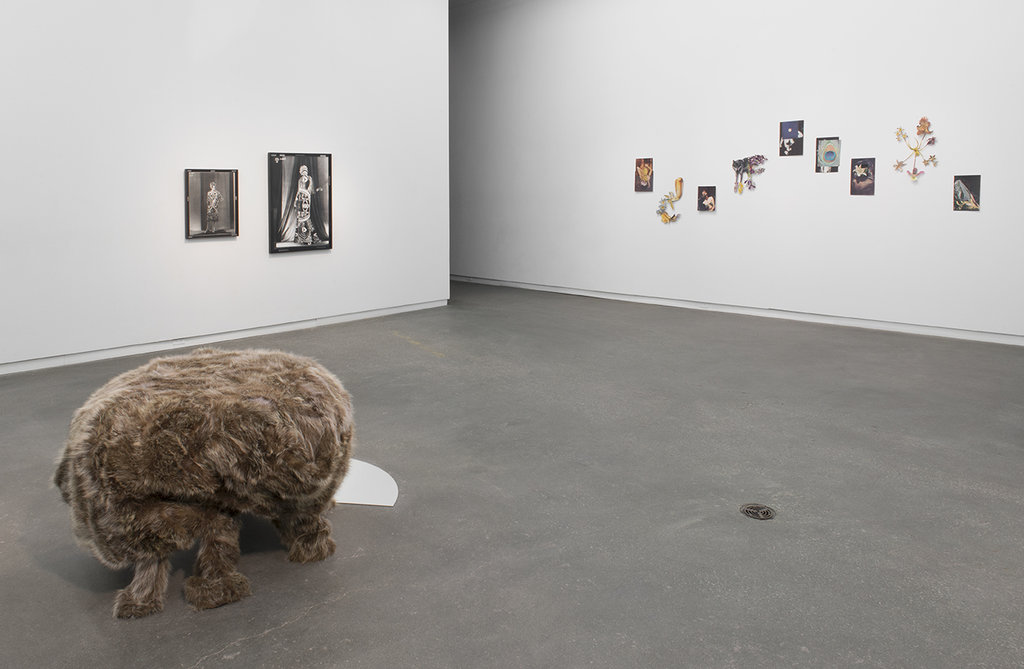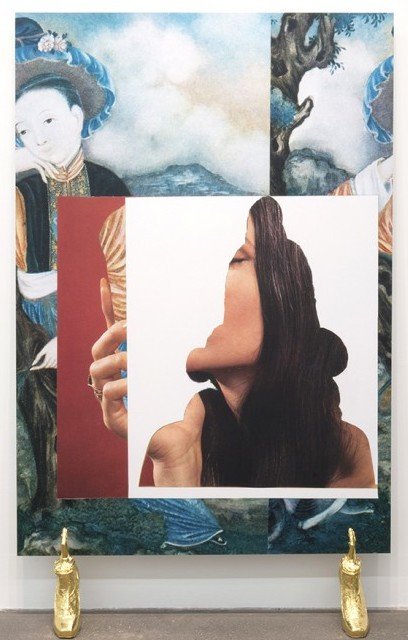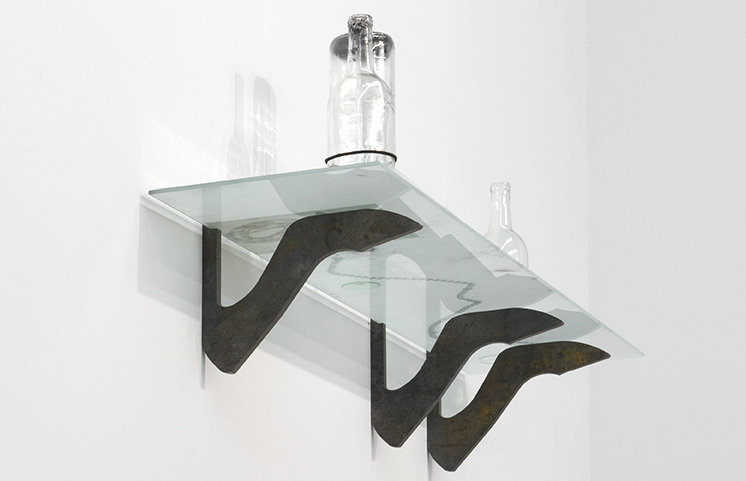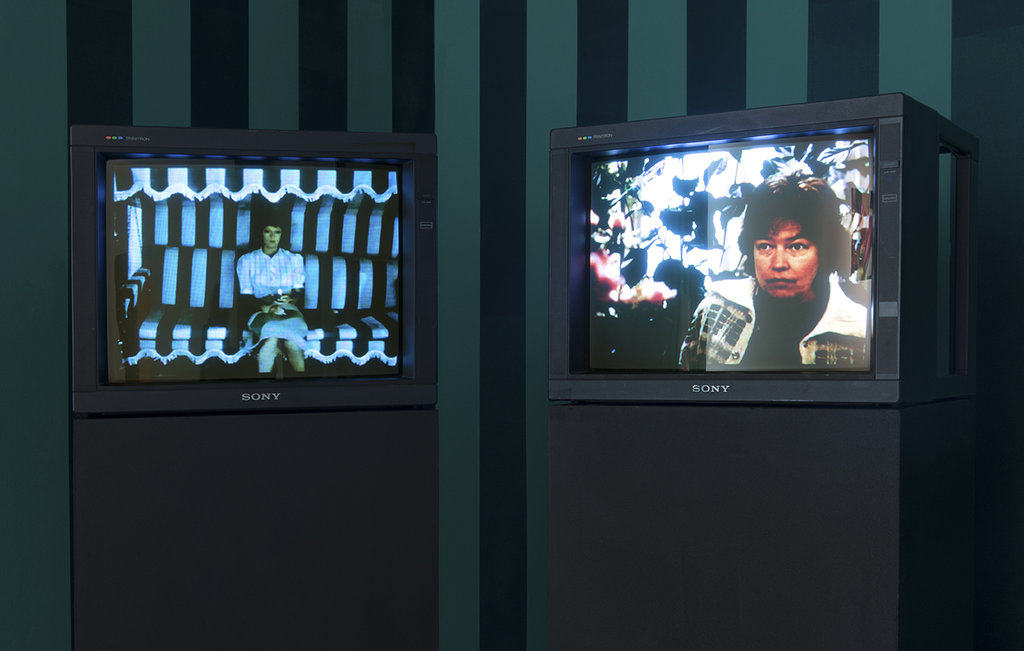 Installation view of Nasty with with Kara Hamilton, Tonka 2016 (in front) at Daniel Faria Gallery, 2017. Courtesy of Daniel Faria Gallery
Installation view of Nasty with with Kara Hamilton, Tonka 2016 (in front) at Daniel Faria Gallery, 2017. Courtesy of Daniel Faria Gallery
Nasty at Daniel Faria Gallery showcases a captivating assemblage of works in different media that presents the viewer with defacement, inaccessibility and interference patterns. Although the exhibit is replete with talking points, these three themes appeared most prominent.
Defacement
Closer to the central space of the exhibit, Jennifer Murphy’s collage works command the viewer’s attention along the far wall. In each work, flora and fauna supplant the faces of human figures. The viewer is acutely aware that an external component has taken the place of what is expected. One is reminded of Anthropology Professor Michael Taussig’s reflections on defacement (Defacement, 1999). Taussig (among other scholars) discerns that, by defacing any object in an attempt to deactivate it, the object will infallibly become more potent as a result; so, Murphy’s defacement in her collages invests the fragmented figures with greater agency. The collages are visually startling due to their array of colour, serpentine arrangement and undulating form. On Elizabeth Zvonar’s pieces the defaced figures become more perceptible than complete ones, more activated by the virtue of the way that they defaced; rather, they become activated because they are defaced.
 Elizabeth Zvonar, Banana! Stick! Ice-Cream! Dick!, 2016, Inkjet print on Kodak Semi-Matte, mounted on dibond, bronze, 60” x 43″. Courtesy of Daniel Faria Gallery
Elizabeth Zvonar, Banana! Stick! Ice-Cream! Dick!, 2016, Inkjet print on Kodak Semi-Matte, mounted on dibond, bronze, 60” x 43″. Courtesy of Daniel Faria Gallery
 Jennifer Murphy, Orchid Spider, 2015, collage, 24 x 15″ (left) and Iris Wolf, 2015, collage 17” x 16” (right). Courtesy of Daniel Faria Gallery
Jennifer Murphy, Orchid Spider, 2015, collage, 24 x 15″ (left) and Iris Wolf, 2015, collage 17” x 16” (right). Courtesy of Daniel Faria Gallery
Inaccessibility
In the central exhibit space, Nadia Belerique’s glass shelf works provide an unexpected focal point. Although the shelves and their contents are less overtly jarring than Zvonar’s or Murphy’s works, the sheer height of the shelves is not. In fact, it is the physical and bodily process the viewer must engage in in order to view the objects on the shelves that is most intriguing. Even though the objects sit on a pane of glass, allowing the viewer to discern the contents of the shelves, the viewer must still look up to see this. And, even when looking up through the glass, the shelf and its contents remain inaccessible. Like a classic narrative trope, the shelf contents are far enough out of reach to be seen and thereby to render the viewer aware of their physical presence. Echoing the defaced intensity of Zvonar’s works and Murphy’s wall, Belerique’s transparent shelves function as a tool of inaccessibility. It seems that they can only exist at this intimate distance from the viewer, and that they delight in this choreographed play.
 Nadia Belerique, Wet Pillow (Snake), 2017, Glass, steel, assorted objects, 8” x 48” x 10”. Courtesy of Daniel Faria Gallery
Nadia Belerique, Wet Pillow (Snake), 2017, Glass, steel, assorted objects, 8” x 48” x 10”. Courtesy of Daniel Faria Gallery
Interference Patterns
The rear section is a secluded space delineated by a wall that boasts two-tone green vertical stripes. Along the far corner of this space, against the green striped wall, two television sets display Aleesa Cohene’s Like, Like (2009) video installation on a continuous loop. At first glance, the televisions resemble speakers since they are elevated by a wide, rectangular pedestal. Interestingly, the televisions are accompanied by speakers; yet, the speakers are small and are not instantly discernible. The significance of the speakers, though, is that they are there. As a result, the viewer watches the loop on the television, hears the audio that accompanies the video, and presumes that the source of the audio is the television; however, it is the inconspicuous speakers that emit the sound. The viewer is presented with visual and audio phenomena that are in sync. The people on the two television sets are speaking to one another, creating interference.
 Aleesa Cohene, Like, Like, 2009, Two-channel video (7 minute loop), wall painting, scent. Courtesy of Daniel Faria Gallery
Aleesa Cohene, Like, Like, 2009, Two-channel video (7 minute loop), wall painting, scent. Courtesy of Daniel Faria Gallery
Laura Hutchingame
Featured image: Elizabeth Zvonar, Origin of the World, 2010, Inkjet print on Kodak Semi-Matte, mounted on dibond, 22” x 26”, detail. Courtesy of Daniel Faria Gallery
*Exhibition information: Nasty, a group show by Nadia Belerique, Valérie Blass, Shannon Bool, Aleesa Cohene, Kara Hamilton, Kristine Moran, Jennifer Murphy & Elizabeth Zvonar, January 21 – March 4, 2017, Daniel Faria Gallery, 188 St. Helen’s Avenue, Toronto. Gallery Hours: Tue – Fri, 11 – 6; Sat, 10 – 6 pm.
